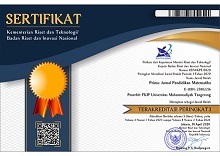ANALYSIS OF THE THINKING PROCESS OF ELEMENTARY SCHOOL STUDENTS INPRES 1 KAWATUNA IN SOLVING AKM PROBLEMS BASED ON WALLAS THEORY IN TERMS OF LEARNING STYLES
Abstract
This study aims to describe students' thinking process in solving Minimum Competency Assessment (AKM) questions based on learning styles. This research uses a descriptive qualitative approach with the method of analyzing the thinking process according to Wallas which includes four stages, namely: the preparation stage, the incubation stage, the illumination stage, and the verification stage. The research subjects consisted of three students, namely one student with a visual learning style, one student with an auditory learning style and one student with a kinesthetic learning style. The data collection technique was carried out through giving a learning style questionnaire, giving AKM test questions and unstructured interviews, after which it was analyzed using the data condensation model, data presentation, and conclusion drawing/verification. The results showed that in the preparation stage, subjects with visual, auditory and kinesthetic learning styles gathered information by reading the questions repeatedly. At the incubation stage, subjects with visual, auditory and kinesthetic learning styles understand the problem well then reflect on ideas to solve the problem. At the illumination stage, visual, auditory and kinesthetic subjects find ideas and express ideas to solve the problem, but at this stage auditory and kinesthetic subjects cannot find more than one idea while visual subjects can find more than one idea to solve the problem. At the verification stage, visual, auditory and kinesthetic subjects express their ideas verbally well, but at this stage auditory subjects do not re-examine the answers they have done while visual and kinesthetic subjects always re-examine the answers they have done.
Keywords
Full Text:
PDFReferences
Amaliya, I., & Fathurohman, I. (2022). Analisis Kemampuan Literasi Matematika Ditinjau Dari Gaya Belajar Siswa Sekolah Dasar. Jurnal Riset Pendidikan Dasar, 5(1), 45–56. https://doi.org/https://doi.org/10.26618/jrpd.v5i1.7294
Anggreini, D., & Asmarani, L. D. (2022). Proses Berpikir Siswa Dalam Menyelesaikan Soal Matematika Ditinjau Dari Gender. Jurnal Riset Pendidikan Dan Inovasi Pembelajaran Matematika (JRPIPM), 5(2), 103–116. https://doi.org/10.26740/jrpipm.v5n2.p103-116
Hastuti, E. S., Umam, K., Eclarin, L., & Perbowo, K. S. (2021). Kecemasan Siswa Sekolah Menengah Pertama Dalam Menyelesaikan Masalah Spldv Pada Kelas Virtual. International Journal of Progressive Mathematics Education, 1(1), 63–84. https://doi.org/10.22236/ijopme.v1i1.6914
Kemendikbud. (2020). AKM dan implikasinya pada pembelajaran. Pusat Asesmen Dan Pembelajaran Badan Penelitian Dan Pengembangan Dan Perbukuan Kementerian Pendidikan Dan KebudayaanPembelajaran Badan Penelitian Dan Pengembangan Dan Perbukuan Kementerian Pendidikan Dan Kebudayaan, 1–37.
Meriana, T., & Murniati, E. (2021). Analisis Pelatihan Asesmen Kompetensi Minimum. Jurnal Dinamika Pendidikan, 14(2), 110–116. http://ejournal.uki.ac.id/index.php/jdpDOI:https://doi.org/10.51212/jdp.v14i2.7
Novianti, D. E. (2021). Asesmen Kompetensi Minimum (AKM) dan Kaitannya dengan Kemampuan Pemecahan Masalah Matematika. Seminar Nasional Pendidikan LPPM IKIP PGRI Bojonegoro, 85–91.
Sidney, P. G., Thalluri, R., Buerke, M. L., & Thompson, C. A. (2019). Who uses more strategies? Linking mathematics anxiety to adults’ strategy variability and performance on fraction magnitude tasks. Thinking and Reasoning, 25(1), 94–131. https://doi.org/10.1080/13546783.2018.1475303
Sulis Setyowati, Purwanto, sudirman. (2022). Analisis Commognitive Siswa Dalam Menyelesaikan Masalah Lingkaran Ditinjau Dari Gaya Belajar. Jurnal Cendekia: Jurnal Pendidikan Matematika, 6(2), 2336–2351.
Tandililing, P. (2019). Profil Proses Berpikir Siswa Dalam Pemecahan Masalah Matematika Materi Luas Permukaan dan Volume Bangun Ruang Kubus dan Balok Ditinjau Dari Tingkat Kemampuan Berpikir Kreatif Di Kelas VIII C SMP Negeri 5 Jayapura. Jurnal Ilmiah Mandala Education, 5(2), 9. https://doi.org/10.36312/jime.v5i2.752
DOI: http://dx.doi.org/10.31000/prima.v9i2.13933
Article Metrics
Abstract - 908 PDF - 270Refbacks
- There are currently no refbacks.
Prima: Jurnal Pendidikan Matematika
Program Studi Pendidikan Matematika
Fakultas Keguruan dan Ilmu Pendidikan
Universitas Muhammadiyah Tangerang
Jl. Perintis Kemerdekaan I/33, Cikokol
Kota Tangerang, Indonesia
e-mail: primajpm@gmail.com
Prima: Jurnal Pendidikan Matematika (p-ISSN: 2579-9827 | e-ISSN: 2580-2216) is licensed under a Creative Commons Attribution 4.0 International License.







